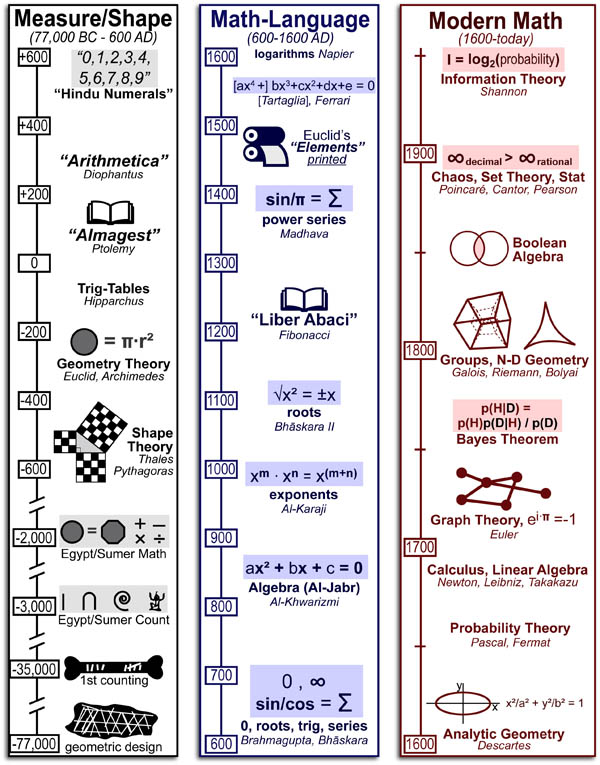The history of mathematics can be divided into three periods:
- The Measurement and Shapes period (<77,000BC - 600AD): Mathematics first rose to preeminence with the agricultural revolution, around ~8,000BC, as a “practical tool“ to organize economics and civilization(trade, accounting, taxes, etc.). Only with the Greeks (~600BC) did mathematics become a “pure subject“ which was pursued for the purpose of “understanding”. Unfortunately, the Roman Empire did not share the Greek’s interest in “pure knowledge” and Europe forgot much what it had learned for the next 1000 years.
- Where the first period “explored” the second period formally “mapped out“ “Mathematics as a Language (600-1600AD)”. As mathematics and science fell from favor in the Western World, Indian and Arab scholars took up the torch to build the foundation of modern mathematics. This period was characterized by a formalization of algebra and trigonometry near to that we use today. These new developments eventually spread to Europe through Italy (>1200) as a trading hub between the West and East.
- Finally, the invention of the printing press lit the fuse for a collaborative explosion of ideas that characterized Modern Mathematics (1600-today).
REFERENCES:
- Katz, V.J. A History of Mathematics: An Introduction 3rd Ed., 2009, Pearson Education
- Mlodinow, L. The Upright Thinkers, 2015, Pantheon Books
- Henshilwood, C.S.; d’Errico, F.; Yales, R.; Jacobs, Z.; Tribolo, C.; Duller, G.A.T.; Mercier, N.; Sealy, J.C.; Valladas, H.; Watts, I.; Wintile, A.G. Emergence of Modern Human Behavior: Middle Stone Age Engravings from South Africa Science, 2002, 295, 1278-1280
- Bogoshi, J.; Naidoo, K.; Webb, J. The Oldest Mathematical Artefact The Mathematical Gazette, 1987, 71, 294.
- Fauvel, J. Using History in Mathematics Education, For the Learning of Mathematics, 1991, 11, 3-6.
- Branford, B. A Study of Mathematics Education, 1908, University of Oxford.

This work by Eugene Douglass and Chad Miller is licensed under a Creative Commons Attribution-NonCommercial-ShareAlike 3.0 Unported License.

